The Gift of South Dakota
Subscriptions to South Dakota Magazine make great gifts!
Subscribe today — 1 year (6 issues) is just $29!
Jelly for Scrimpers
Corncob jelly is a curiosity of old cookbooks, something that conjures visions of pioneer households and frugal living. It takes a real scrimper to look at a bare cob destined for the cookstove or outhouse and think, “Gosh, I wish I could get one more use out of that.”
In lieu of actual evidence, we tend to assume that all foods were invented via the accidental collision method made famous in Reese’s Peanut Butter Cups commercials of the 1970s and ’80s. Can’t you imagine two pioneer women bumping into each other on the prairie, saying, “You got your corncobs in my pot of boiling hot sugar water!” “Oh yeah, well you got YOUR sugar water on MY corncobs!” before they realize that the resulting mélange is delicious?
Maybe, maybe not. In the early days of Dakota homesteading, salting, drying or storing food in the root cellar were more common methods of food preservation than canning. Oh, canning existed — a French cook, Nicholas Appert, won 12,000 francs off Napoleon Bonaparte in 1810 for developing a food-storage system that would help keep the French army fed and in fighting condition. Appert’s approach involved putting food in jars, corking them and sealing them with wax. The jars were then wrapped in canvas and boiled. In 1858, Philadelphia tinsmith John Landis Mason patented the Mason jar and accompanying zinc screw-on lid. The Ball brothers and others ran with the concept after Mason’s patent ran out in 1879. Lightning jars (glass canning jars with glass lids) came along in the early 1900s, and it wasn’t until 1915 that Alexander Kerr came up with the two-piece lid that home canners use today.
Settlers were certainly canning in Dakota Territory by 1875. Jellies, pickles and preserves went on display at the first territorial fair, held in Yankton on September 29-30 of that year. Corncob jelly didn’t make an appearance, but pear preserves, cherry and peach pickles and jarred plums all won awards. (Mrs. A. J. Faulk, wife of the former territorial governor, won a prize for her chokecherry jelly, but considering that her daughter, wife of prominent territorial politician/crook Walter Burleigh, was one of the judges … well, perhaps you’ll pardon our cynicism.)
All politics aside, we can all appreciate the fact that corncob jelly never was the first jar of preserves our grandmothers set out when company came, and they probably chose flashier recipes to submit to the church cookbook. However, we did locate a modern-day corncob jelly aficionado at Colome, where Fran Hill writes a food blog (my-plate.blogspot.com) and also finds time to make jams and jellies with all sorts of South Dakota blessings — from wild grapes to apples, beets and chokecherries.
“One of the first cookbooks that I owned as a newlywed contained a heritage recipe for corncob jelly,” Hill says. “It called for dried red corncobs from field corn used to feed livestock. The cobs were weighted down in a large pot of water and boiled to create a rosy-colored stock from which the jelly was made. The entry claimed it would taste like apple, and I was immediately curious.”
Hill begged her farmer-husband, Brad, for dried corncobs, but he patiently explained that cobs went out of fashion with yesterday’s corn pickers. Modern grain combines chew up and spit out the cobs, leaving them fit for little more than compost.
We grow 5 million acres of corn in South Dakota. That’s nearly a billion bushels, and yet cobs are hard to collect for many canners.
However, years later the ever-resourceful Hill began to strip her garden sweet corn for freezing and soon found herself ankle-deep in good cobs. “Now I had the Internet on my side when I searched for corncob jelly,” she says. “I tested a few recipes and found a method that suited me. It does somewhat taste like apple jelly, although not nearly as tart.”
For jelly with a little kick, she adds finely diced jalapeño to simmer with the corn stock before adding the sugar. Cloves, cinnamon sticks, star anise, cardamom pods, or a combination of any or all could be simmered with the corncobs when making the stock for a different kind of spice.
“The recipe is as adaptable as the homesteaders that created the concept of corncob jelly,” Hill says. Here is her recipe.
Corncob Jelly
12 ears sweet corn
water
1 tablespoon lemon juice
3 1/2 cups sugar
1 box (1.75 ounce) pectin
Before making the jelly, prepare the canner, jars and lids. Fill the canner with water, bring it to a boil, sterilize the jars and heat the lids according to the manufacturer’s directions.
Cut the corn kernels from the cobs. Set the corn aside for supper; it isn’t needed for this recipe.
Put the corncobs into a large, heavy pot. Add enough water to cover. Bring to a boil. After the corn stock has cooked for 1 hour, measure out 3 1/2 cups of liquid. At this point, you can strain out the bits of stray corn that loosened from the cobs, but I don’t. I like the added texture and interest.
In a smaller, heavy pot, bring the 3 1/2 cups of corn stock and lemon juice to a boil. Stir in the sugar. When sugar has dissolved and the mixture returns to a boil, add the pectin. Return to a hard boil for 1 minute, stirring constantly.
Ladle into sterilized jars, leaving a 1/2-inch headspace, and seal. Process for 10 minutes in the water bath canner. (Yield: 3 pints … I use 1/2 and 1/4-pint jars.)
Note: If you are unsure of the canning process, there are many informative websites that can help.
Editor’s Note: This story is revised from the September/October 2018 issue of South Dakota Magazine. To order a copy or to subscribe, call (800) 456-5117.


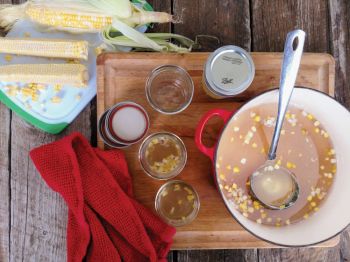
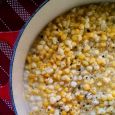
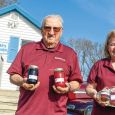
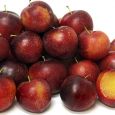

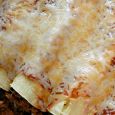



Comments